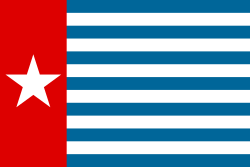Hai tanahku Papoea,
Kaoe tanah lahirkoe,
Koe kasih akan dikaoe
sehingga adjalkoe.
Koekasih pasir poetih
Di pantaimoe senang
Di mana laoetan biroe
Berkilat dalam trang.
Koekasih goenoeng-goenoeng
Besar moelialah
Dan awan jang melajang
Keliling puntjaknja.
Kukasih dikaoe tanah
Jang dengan boeahmoe
Membajar keradjinan
Dan pekerdjaanku.
Koekasih boenji ombak
Jang poekoel pantaimoe
Njanjian jang selaloe
Senangkan hatikoe.
Koekasih hoetan-hoetan
Selimut tanahkoe
Koesuka mengembara
Di bawah naoengmoe.
Sjoekoer bagimoe, Toehan,
Kaoe brikan tanahkoe
Bri aku radjin djoega
Sampaikan maksud-Moe. [3] | Hai tanahku Papua,
Kau tanah lahirku,
Ku kasih akan dikau
sehingga ajalku.
Kukasih pasir putih
Di pantaimu senang
Di mana lautan biru
Berkilat dalam terang.
Kukasih gunung-gunung
Besar mulialah
Dan awan yang melayang
Keliling puncaknya.
Kukasih dikau tanah
Yang dengan buahmu
Membayar kerajinan
Dan pekerjaanku.
Kukasih bunyi ombak
Yang pukul pantaimu
Nyanyian yang selalu
Senangkan hatiku.
Kukasih hutan-hutan
Selimut tanahku
Kusuka mengembara
Di bawah naungmu.
Syukur bagimu, Tuhan,
Kau berikan tanahku
Beri aku rajin juga
Sampaikan maksudMu. | O mijn land Papoea
Mijn geboorteland
Jou zal ik liefhebben
Tot mijn levenseinde
Ik hou van het witte zand
Van je fijne stranden
Waar de blauwe oceaan
Blinkt in het licht
Ik hou van de bergen
Groot en verheven
En de wolken die zweven
Om hun toppen
Ik hou van je grond
Die met je vruchten
Mijn ijver betaalt
En mijn werk
Ik hou van het geluid van de branding
Die op je stranden slaat
Een lied dat steeds
Mijn hart verheugt
Ik hou van de bossen
Het dekkleed van mijn land
Ik mag zo graag zwerven
Onder je schaduw
Dank zij u Heer
Gij hebt mij het land gegeven
Laat mij ook ijverig zijn
Om het te laten beantwoorden aan Uw doel [4] | Oh Papua, my land
Where I was born and raised
Thee I shall always love
Till' my day of eternal rest comes
I love the whiteness of your sands
On your beaches, joyful
Where the azure seas
Sparkle bright in the day
Your high peaks I adore
Majestic and grand
Sublime clouds, surrounding
Around the tops, they do
I love this land of mine
Naturally abounding with bounty
That shall pay me off
and my labour in full
Thy roaring waves, I am smitten with
Ever crashing against your white, sandy beaches
A melody that shall eternally
In my heart remain
I love the sprawling forests
That this land is built upon
'Tis rapture to traipse
Under its benevolent shade
Thank you, oh Lord on high
This land of mine, Thine creation
Task me to labour ceaselessly too
To spread Thy cause, far and wide. [1] |

